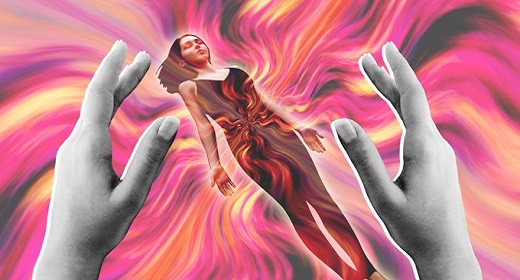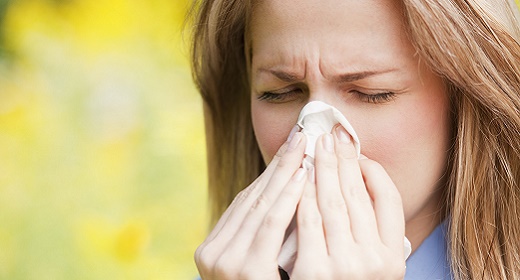by Arianna Rebolini: If you know what I’m talking about when I talk about reiki, you likely feel strongly about it…
Maybe you describe it as the life-changing saving grace to your chronic back pain, or maybe you’re certain it’s quackery capitalizing on people at their weakest. At least for those moved to write about it on the internet, there’s little middle ground.
For everyone else, a brief explainer: Reiki is a spiritual healing practice which originated in Japan in the early 20th century, and is built on the belief that the body is innately able to heal itself. The word “reiki” loosely translates to “universal life energy” — an energy which practitioners believe exists within, and surrounds, each body — and the practice involves transmitting or balancing that energy, through the specific placement of hands on or above a recipient’s (fully clothed) body. Most commonly, reiki is used to ease pain, anxiety, fatigue, and depression, but since at its core is the conviction that the body in its natural state can heal any ailment, the applications, theoretically, are endless. However, the few, small studies on the practice have yet to yield much evidence of its efficacy (though the research has also found that it doesn’t appear to be harmful).
Six months ago, when I walked into my first reiki appointment at a Santa Fe oxygen spa, I had only ever heard the word in passing, and I didn’t really know what to expect. The spa’s description spoke vaguely about healing and relaxation; I thought I’d paid for a massage. What I got was one of the strangest experiences of my life: an hour in which my practitioner waved his hands over me and blew smoke across my body, to which my body responded with warm tingling in my arms and hands, mysterious pressure on my chest, and uncontrollable tremors in my legs. It was unexpected, a little scary, and definitely not relaxing.
According to my practitioner, these sensations indicated an energy blockage being released; they were merely signs that the session was working. He told me my body was returning to its natural state, i.e. “nearly orgasmic” energy. But it didn’t feel orgasmic. It felt crazy. I tend to be a cautious believer, but even I couldn’t accept this as the cause and effect. I needed to know: what had happened to my body?
***
What complicates discussion of reiki is that, unlike alternative medicines which have become more integrated into Western medicine such as acupuncture and chiropractic, reiki is unregulated. The result of this is a proliferation of many and varied manifestations of the practice, influenced by different historical traditions and lineages, and often linked by little other than the practitioner’s calling it reiki. This dispersal of technique can be a source of frustration to those who’ve trained in the specific method as developed by the man generally accepted as the founder of modern reiki, Mikao Usui.
So far, the research cautions that reiki should be used in conjunction with, and never instead of, conventional treatments for conditions like pain, anxiety, or depression. But if reiki is to be used with conventional medicine, then there first needs to be clarity around what, precisely, reiki even is. Practitioners going rogue, blending multiple spiritual practices into something new and naming it reiki, muddies the already sparse data. One person who is working toward a singular definition of the practice for patients, practitioners, and medical professionals is Pamela Miles.
Miles, author of Reiki: A Comprehensive Guide, is the unofficial leader of the movement to legitimize reiki in the mainstream. Having practiced and researched reiki for over 31 years, Miles has published in multiple peer-reviewed medical journals, collaborated on NIH-funded medical research, taught reiki at medical schools, and spoken about reiki in the media. Though she doesn’t necessarily advocate for uniform regulation of the practice, she does emphasize the importance of continued research on its effectiveness, and for the education of those receiving it. When I described my experience to Miles over the phone, she wasn’t entirely convinced she’d call what happened “reiki” at all.
“I cannot speak to any particular experience, but the kinds of things you described sound more like an energy medicine, a shamanic approach, where the practitioner was moving the energy, clearing the obstacles.” I was confused. Isn’t that exactly what reiki is?
Ideally not, according to Miles. When practiced according to its origins, she explained, reiki was less about intervention, and more about reestablishing the power already within the recipient to heal oneself. (How you feel about that description depends largely on your tolerance for all things woo.) The practitioner should only be facilitating that power, resulting, most immediately, in a sense of relaxation and stress relief. Regardless, my reaction was hardly unique. When I took to Google shortly after my session — looking up phrases like “shaking during reiki,” “body moving during reiki,” “can I die from reiki,” etc. — I found pages upon pages of testimonials echoing my experience, both from practitioners witnessing those reactions in the recipients, and from the recipients themselves. The explanations, usually provided by other members within the forums, were along the lines of what the practitioner had told me: it was an “energy shift,” or “fluctuations of ki.” But what did that actually mean? For those seeking scientific explanations, unfortunately, the answer is … well, there is no answer.
The National Center for Complementary and Integrative Health (NCCIH) lumps reiki, along with similar but distinct practices like therapeutic touch and Chinese qigong, within the category of “biofield therapy,” but any definition of “biofield” is maddeningly vague. The clearest description we have is from a 1992 conference, when the NIH defined it as “a massless field, not necessarily electromagnetic, that surrounds and permeates living bodies and affects the body”; however, the NIH has since backed away from that description. In an emailed statement, the NCCIH told me, “to our knowledge there is no current definition of biofield that has been determined by the NIH.” When I asked Miles for more clarity, she explained the NIH’s proposed term describes “the purported subtle vibrational field that surrounds and penetrates the human body,” adding that it’s still a working definition. To my understanding, reiki practice holds that it is the manipulation of this field which causes either physiological distress or allows self-healing. No scientific proof of the biofield exists.
According to Miles, this mystery around the biofield and, in turn, the underlying mechanism of reiki itself doesn’t negate the power of the practice. Indeed, medical professionals have a long history of using medicine before understanding its mechanism of action. Bayer released aspirin in 1897 and it became the most widely used drug in the world; we didn’t know how it worked until 1971. Scientists are still theorizing how anesthesia works. Ditto antidepressants. What’s more, Miles emphasizes, reiki, like meditation, is at its core a spiritual practice being used in medical intervention, and the mechanism of spiritual practice isn’t necessarily provable by scientific technique. But that shouldn’t have any bearing on reiki’s effectiveness, Miles argues.
Unfortunately, clinical research doesn’t tell us much about that effectiveness, either. A 2009 review of clinical trials found only 12 out of the 76 available which met methodological standards. Most of those 12 trials (which tested effects of reiki on depression, anxiety, stress, memory, and mental function in Alzheimer patients) reported positive outcomes, but conclusions drawn from them are less compelling for the small population size and the lack of consistency among the measures of those outcomes — some results were drawn from heart rate, others from mental-state examinations, others from self-reported questionnaires. It seems too, that, as with the practice of certain types of meditation, some reiki practice might aggravate anxiety in those prone to it. While the NIH reports no harmful side effects of reiki, some practitioners acknowledge the possibility of patients experiencing not only anxiety, but also short-term upset stomach, light-headedness, and fatigue. The danger arises when patients trade conventional care for only reiki.
But this is a service, often a pricey one (insurance rarely covers it, and treatment can cost up to $400 per session), and customers wouldn’t be paying and returning if they weren’t benefiting from it. That evidence is mostly anecdotal, seen in gushing testimonials by patients — like Anne in Rochester, New York, who said reiki gave her the “gift of freedom,” attributing a “release of depression, anxiety and feelings of abandonment” to the sessions. And there’s no denying that medical professionals are recommending reiki to patients or training as masters themselves. About 60 U.S. hospitals offer reiki sessions, including New York-Presbyterian, Memorial Sloan Kettering, and UCLA Medical Center; as of 2014, over 800 hospitals offer reiki training.
Dr. Ann Berger, chief of pain and palliative care at the NIH Clinical Center, explained via email exchange that the benefits they observe in patients “relate to helping with psychosocial spiritual distress which is part of the total pain picture.” Though she didn’t confirm an increase in physicians using reiki, she acknowledged that if there were one, it might have to do with an industry-wide interest in finding alternatives to opiates. In an online testimonial, Danica Fiaschetti from UCLA’s Urban Zen Integrative Therapy writes about practicing reiki on a patient who could no longer receive pain medication: “The amazing thing was that the heart rate of the patient went down as the patient began to relax […] Wonderful experience, and the patient felt better.” Others describe first-hand experience of patients reporting relief from pain, stress, fear, and insomnia.
One possible explanation of reiki’s observed benefits might have to do with recent findings on placebos — that is, that the “placebo effect” might offer more opportunities for symptom management than previously thought. This research is led by Ted Kaptchuk, director of Harvard Medical School’s Program in Placebo Studies & Therapeutic Encounter. Kaptchuk’s past research has demonstrated what is now commonly known about placebos (that when delivered with a suggestion of possible side effects, trial participants will often self-report those side effects) but a recent discovery is more surprising. It turns out sugar pills can ease symptoms in patients even if those patients know they’re receiving sugar pills, and even if those pills are given without any suggestion about the results the patients might see. It suggests a holistic look at the experience of healing, a therapeutic element to the doctor-patient interaction in full.
“What’s going on in the patient’s [mind] is that the rituals of medicine, the symbols of medicine, and a warm, empathetic doctor (in the context of a clinical encounter) activate neurotransmitters in the brain, activates specific quantifiable and relevant brain regions that release these neurotransmitters,” Kaptchuk told Vox. It’s these neurotransmitters which can intensify or abate certain symptoms.
So the placebo effect isn’t about trickery or deceit; it might just be a different option for care. And yet the “benefits of therapies such as reiki and acupuncture go beyond what we normally think of as placebo effects,” writes Jo Marchant, author of the 2016 book Cure: A Journey Into the Science of Mind Over Body. It isn’t about fooling patients; instead, she argues, many aspects of the care that alternative medicine practitioners “provide — from talking to touch — seem to have the power to relieve symptoms and even influence physical outcomes. … Conventional medicine, with its squeezed appointment times and overworked staff, often struggles to provide such human aspects of care.”
The psychological power of reiki (or placebo) certainly has its limits. It can’t cure cancer or stabilize an arrhythmia, but what it can do is ease pain, stress, and fatigue — which, perhaps not so coincidentally, is exactly where patients have benefited from reiki.
***
So where does my reaction — echoed by many other personal accounts — fit in? I didn’t walk in with a specific ailment, but something physical happened, irrefutably. Did I just have to accept it as a result of a shift in energy I couldn’t possibly understand? Maybe.
But maybe, too, it had more to do with the practitioner than with me. After all, before the session began, my practitioner had warned me (somewhat ominously) that “physical sensations would come up,” and along the way he explained my body’s need to release energy. And according to Miles, the manifestation of our reactions to reiki can be shaped by the practitioner’s influence.“In my more than three decades of professional practice,” she said, “I’ve often wondered if the reason I don’t see that kind of screaming or drama is because I have never felt a need for my clients to have that kind of experience.”
What’s clearest to me now is that to obsess over why and how reiki may help is to distract others from the fact that, often, it does. “There is consensus in the medical community that Reiki practice is non-invasive and low-risk,” Miles wrote in a follow-up email. “What is needed is to document benefits.”
Research on reiki right now is scarce; that which exists shows little proof of effectiveness, but also little danger when used in tandem with conventional treatment. In other words, if it makes you feel good, godspeed.









































